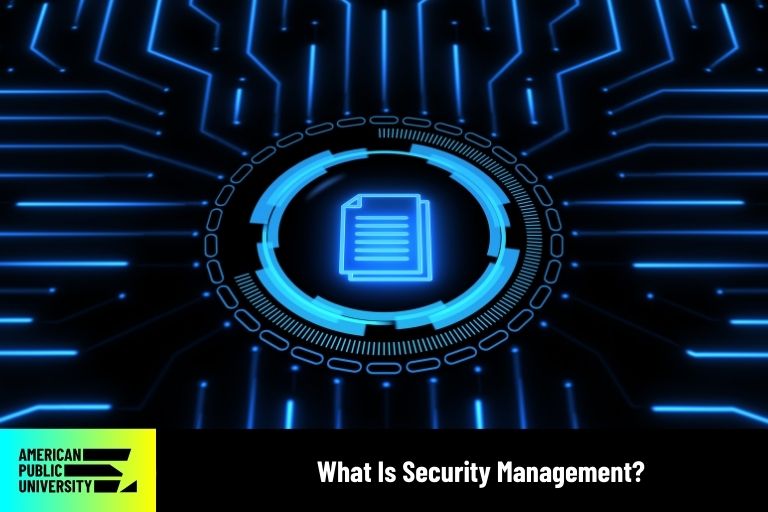05/22/2025

Security management is the structured approach to protecting an organization’s people, physical assets, and digital infrastructure. It includes developing policies, setting procedures, and using technology to identify and reduce risks.
From managing physical access to safeguarding sensitive data, security management supports business continuity by reducing the impact of internal errors and external threats.
How Security Management Supports Daily Operations
Security management focuses on anticipating risks before they become serious issues. This includes implementing access controls, educating employees, monitoring systems, and preparing for emergencies.
Many organizations rely on security management systems that combine physical and digital protections. These systems define how to handle security incidents, outline policies for data access, and ensure compliance with industry standards.
Security management helps build an organization-wide awareness of potential threats while setting expectations for behavior and response.
Why Risk Management Matters in Security Planning
Risk management helps organizations identify what might go wrong and prepare for it. This process starts by pinpointing key assets, such as customer data, facilities, or digital systems, and evaluating the risks they face. These risks might include cyber threats, human error, or natural disasters.
Security teams then assess how likely each threat is and what the impact could be. This helps prioritize resources and supports decision-making in security planning. Risk management also plays a role in recovery efforts, helping organizations adapt when challenges arise.
For students interested in security management, risk assessment is a key concept that connects strategy with real-world application.
How Information Security Management Protects Data
Information security management focuses on protecting digital data from unauthorized access, damage, or misuse. This includes putting safeguards in place to preserve data integrity and ensure only the right people can access sensitive information.
Organizations often adopt structured frameworks such as ISO 27001 or the NIST Cybersecurity Framework to guide their policies and practices. These tools help organizations detect and prevent cyber threats while maintaining data availability for authorized users.
Information security management also involves employee training to help teams recognize and avoid risky behavior online.
What To Know About Security Risk Management
Security risk management brings together planning, prevention, and response to help protect physical and digital environments. This process identifies vulnerabilities, evaluates potential impact, and supports real-time decision-making when an incident occurs.
A strong security risk management plan may include regular security assessments, updates to security controls, and incident response testing. The goal is to reduce the likelihood of threats and improve recovery time if something happens.
Security risk management may support compliance efforts and strengthens an organization's ability to protect its assets.
Key Elements of Cyber Security Management
Cyber security management focuses on protecting digital systems and networks from unauthorized access, data breaches, and other cyber threats. This includes installing tools like firewalls, intrusion detection systems, and encryption software.
Organizations also use cyber security management to train employees, track user identities, and detect suspicious activity. These steps help identify vulnerabilities early and reduce the risk of system disruption.
Cyber security management combines technical tools with proactive planning to keep digital operations secure and stable.
Why Security Policies Are Essential
Security policies provide a clear set of rules for how organizations handle sensitive data, manage access, and respond to threats. These policies set expectations for employee behavior, outline roles, and define how to report incidents.
Strong internal policies may help organizations ensure compliance with legal and regulatory standards while reducing confusion in high-stress situations.
Security policies also reinforce the importance of consistency, making sure that all team members follow the same rules and understand their responsibilities.
The Role of Security Controls in Organizational Protection
Security controls are the tools and processes used to enforce a company’s security strategy. These can be physical, such as key card systems and security cameras, or digital, like firewalls and access logs.
Administrative controls, such as employee training and written procedures, also play an important part in shaping everyday behavior.
Regularly testing and updating these controls helps ensure they work as intended. Security controls serve as the hands-on layer of protection that turns policies into action.
How Cyber Security Helps Prevent Attacks
Cyber security protects an organization’s digital environment from attacks like phishing, malware, and ransomware. It’s an ongoing process that involves securing systems, educating users, and preparing for new and evolving cyber threats.
Effective cyber security may include monitoring tools that flag unusual activity, encryption to protect sensitive data, and access restrictions based on user roles.
By building defenses across systems and educating staff, organizations can reduce vulnerabilities and stay resilient in the face of digital challenges.
Responsibilities of a Security Manager
A security manager oversees the development and execution of security programs. This role involves planning, coordinating teams, monitoring compliance, and leading incident response efforts.
Security managers often assess vulnerabilities, develop employee training programs, and recommend updates to security technologies. They also work with leadership to align security practices with business goals.
The role of the security manager is vital for creating a consistent and proactive approach to organizational protection.
Understanding Access Management
Access management helps control who can view or use resources within an organization. It ensures that only authorized individuals can access sensitive systems or information.
This process may include user authentication, access logs, and multi-factor authentication. Access management also supports compliance by showing that access to data is tracked and reviewed regularly.
By limiting exposure to critical systems, organizations may reduce the chances of security breaches or misuse of data.
Why Information Security Is Foundational
Information security protects data across its lifecycle, from collection and storage to sharing and disposal. It helps maintain confidentiality, ensure availability, and preserve the integrity of important information.
Common practices in information security include secure backups, user access controls, and ongoing monitoring. These measures help defend against data breaches and support business continuity during technical disruptions.
When information security is prioritized, organizations are better prepared to build trust and safeguard their reputation.
How Incident Response Supports Business Continuity
Incident response is the structured plan organizations follow when a security incident occurs. This includes identifying the issue, containing the threat, removing any harmful elements, and restoring normal operations.
A clear incident response plan defines roles, outlines communication protocols, and provides steps for recovery and review. It also helps identify gaps in existing protections and supports long-term improvements.
Being prepared for incidents can help reduce their impact and speed up the recovery process.
Building a Culture of Security Awareness in Security Management
For students considering a future in security management, it’s important to recognize that this field isn’t just about technology—it’s about people, too. Creating a security-aware culture is a core part of many security strategies. This means not only understanding the technical tools but also learning how to educate teams, enforce consistent policies, and adapt to evolving risks.
In your studies, you may explore how organizations promote awareness across different levels, from training employees to follow best practices to developing frameworks that guide everyday decisions. These lessons can help you see how security management works beyond systems—shaping behaviors, improving communication, and strengthening overall defenses.
By understanding how to build a culture of security awareness, you may be able to prepare for roles that involve both technical knowledge and leadership in fostering safer environments.
Curious about typical career paths within this field? Dive into "What Jobs Can You Get With A Security Management Degree?".

